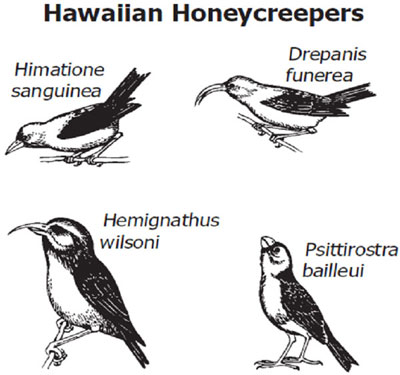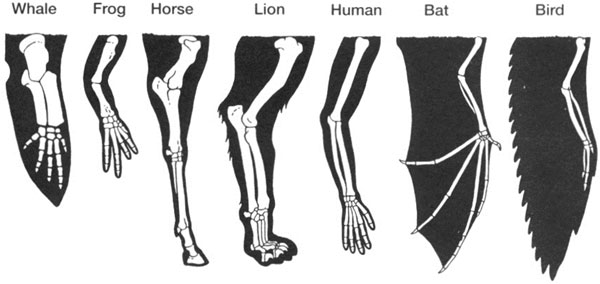
The different species of Hawaiian honeycreepers shown here all descended from a single species of North American bird. They now have different beaks, eat different foods, sing different songs, and live in different environments on the islands. Which factor probably contributed most to the variation among these different species?

A. Loss of habitat
Incorrect. Loss of habitat would impact all of the parent population rather than supporting a situation where variation could occur.
B. Geographic isolation
Correct! Separation of populations of a species by geographic means (distance, mountains, oceans, etc.) that over time that species will evolve characteristics different from the parent population.
C. Egg size
Incorrect. Egg size does not impact variation among species.
D. Predation
Incorrect. Predation is when a predator attacks and feeds on prey. This relationship does not impact the variation of Hawaiian honeycreepers.
The bones pictured below are an example of –

A. Embryological similarities in organisms
Incorrect. Embryological similarities do provide evidence of a shared common ancestor. However, the picture does not show embryos; rather, it shows the bones of grown animals.
B. traits that have undergone artificial selection
Incorrect. In artificial selection, nature provides a variation, and people select those variations that they find useful. Animals with the selected variations are bred.
C. homologous body structures
Correct! The bones in the picture have different mature forms. However, similarities indicate that the species descended from a common ancestor.
D. the innate tendency toward complexity
Incorrect. The complexities of the bone structures do not support a link to a common ancestor.
Evidence for evolution includes all of the following except –
A. punctuated equilibrium
Correct! Punctuated equilibrium is not evidence for evolution, but rather a criticism of the traditional Darwinian theory of evolution.
B. biogeography and speciation
Incorrect. Biogeography attempts to document and explain the geographical distribution of animals. It gives evidence to the evolutionary formation of new biological species by the division of a single species into two or more genetically distinct ones.
C. the fossil record
Incorrect. The fossil record supports evolution in that it shows the Earth is millions of years old and that over that time species have changed.
D. homologous structures
Incorrect. Homologous structures show that varied species evolved from a common ancestor.
Populations of the same species living in different places –
A. do not vary
Incorrect. Variance occurs in populations over time.
B. always show balancing selection
Incorrect. Balancing selection is a process of natural selection where heterozygous individuals are more adaptive. Populations do not ALWAYS show balancing selection.
C. become increasingly different as each becomes adapted to its own environment
Correct! As species are isolated, they must adapt to their environment. Over time, species become different as they adapt to their environment.
D. all grow at different rates
Incorrect. Growth rates do not explain how populations change over time.